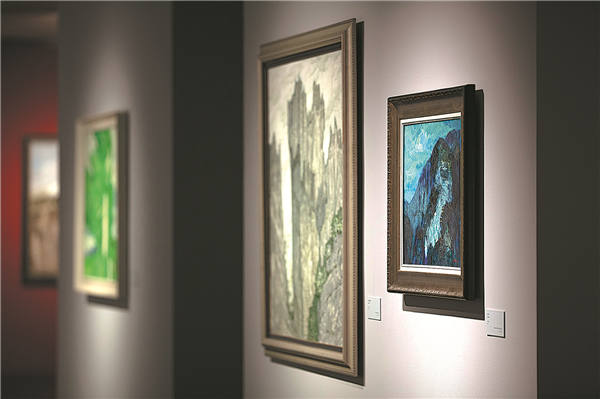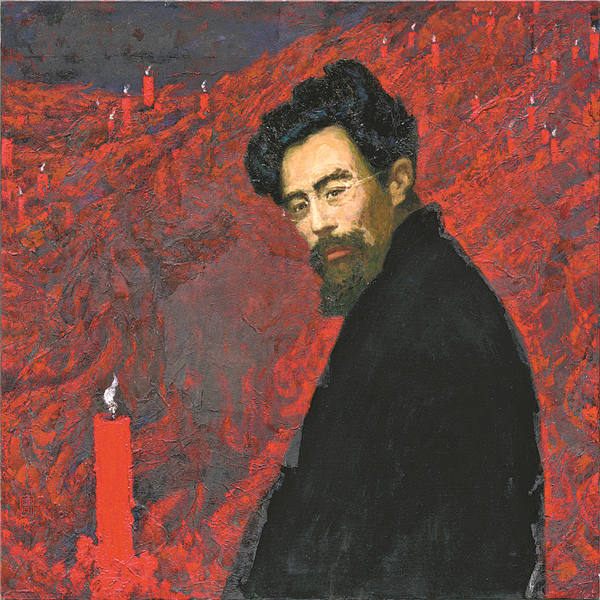


Old photos of Wen Yiduo. [Photo provided to China Daily]
Exhibition at Tsinghua University remembers a cultural luminary, Lin Qi reports.
Wen Yiduo, a literary luminary from the first half of the 20th century, is remembered for his poems, writing and speeches that are exuberant with passion, a spirit of reform, his belief in justice and a deep love of his country and its people.
Wen's most renowned work is the poem Red Candle, written in 1923 when he was 24 years old, in which he adopted a modern style of composing, rather than a classical style, and used the "red candle" as a metaphor to express a young man's persistence with finding a direction in life, and his devotion to pursuing brightness.
Wen's accomplishments were not only in the literary field. He also designed magazine covers, made sketches, produced illustrations and engraved seals. When he was pursuing further studies in the United States in the early 1920s-attending the Art Institute of Chicago, the University of Colorado and the Art Students League of New York-Wen focused on fine arts, literature and theater.
Wen's commitment to modern Chinese art and culture also inspired the career of his youngest son, Wen Lipeng, a noted oil painter and retired professor of the Central Academy of Fine Arts in Beijing, who created an iconic portrait of his father.
The art and intellectual spirit of the father and son are marked at Ode to the Red Candle, an exhibition at Tsinghua University Art Museum, which will run until July 3. While the museum is temporarily closed due to the COVID-19 prevention measures, people can still access the exhibition online as a virtual tour.

Landscape paintings by Wen Lipeng, Wen Yiduo's son. [Photo provided to China Daily]
The Wen family formed an attachment to Tsinghua. At age 13, Wen Yiduo had enrolled in Tsing Hua College, the preparatory school for students to study in the US, and studied there for 10 years. The college was extended in 1925 to become Tsinghua University. Upon returning home from the US, he taught at the university for years afterward. His five children, including Wen Lipeng, spent their childhood at Tsinghua and attended its affiliated primary and secondary schools.
The exhibition shows Wen Yiduo's sketches, designs, seal carvings, documents and dozens of Wen Lipeng's oil paintings. The portrait of his father, depicting a middle-aged Wen Yiduo surrounded by a pyramid of burning red candles, in sharp contrast with his hair, thick eyebrows, beard and gown, all black, delivering a sense of solemnity and determination, is also on display.
Du Pengfei, executive director of Tsinghua University Art Museum, says the exhibition allows people "to understand and remember a generation of Chinese scholars, represented by Wen Yiduo, whose unremitting efforts contributed to social progress and upholds the spirit of a nation".
The exhibition sheds light on Wen Yiduo's talent as an artist and designer, an aspect important to his life, and yet, less well-known to the public.
Shui Tianzhong, the exhibition's academic director and an art critic, says shortly after Wen Yiduo was admitted to Tsing Hua College, he showed his gift for drawing, and he and his former schoolmates, including Liang Sicheng who later became "the father of modern Chinese architecture", founded several societies to research fine arts, music, theater and literature.
People will get a rare view of a collection of illustrations and bookplates Wen Yiduo designed for "Tsinghuapper", a Chinese-English annal of 1921 which introduces the classes, teachers and extracurricular activities. The designs show a blend of Chinese cultural traditions and elements from Western art. A copy of the annal is also on display for visitors to see.
|<<Previous123Next >>|

A portrait of Wen Yiduo by Wen Lipeng is displayed at the show held at Tsinghua University Art Museum. [Photo provided to China Daily]
Liang Shiqiu, a renowned author and friend of Wen Yiduo at Tsing Hua College, said of his "Tsinghuapper "illustrations that "countless flowers are blooming in profusion from a single brush".
Wen Yiduo's works not only express his pursuit of ideals, beauty and truth, but also a love of his country and home culture. "The sentiments only intensified while he was abroad," Shui says. "He later recalled, 'I missed the mountains and waters in China, the woods, animals, buildings and the people.'"
Wen Yiduo once said, "I love China because it is my motherland, but particularly because of its venerable culture."
Tsinghua relocated to Hunan province in 1937 to evade Japanese invasion, and months later to Kunming, Yunnan province. Wen Yiduo, along with some students and staff members, walked for 68 days from Changsha to Guizhou province and finally to Kunming. He made 36 sketches during that time, which show the landscapes, the cultural sites and people's lives during the War of Resistance Against Japanese Aggression (1931-45). These works are also on show.
Wen Lipeng says, "It was at Tsinghua where my father began to paint. A century has passed, and his 'Tsinghuapper' works have returned for the show at his alma mater.
"He expressed beauty with his brush, extolled beauty with his poetry, appreciated beauty with his words, and devoted his life to creating beauty."
点击右上角![]() 微信好友
微信好友
 朋友圈
朋友圈

请使用浏览器分享功能进行分享
